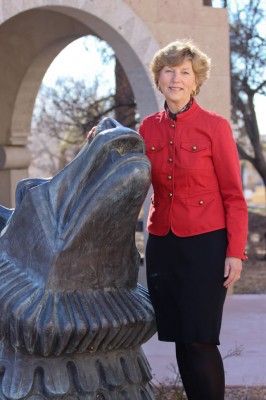
University Counsel
The University of New Mexico
Albuquerque, NM
I’ve spent almost my entire legal career in higher education. I’ve practiced law in six states and on three campuses, and I’ve worked for the NCAA. I’ve seen lots of trends and fads come and go, but this growing idea of public-private partnerships at universities is one that just makes sense.
I love working in this field, because a university is the best client a lawyer can have. It’s interesting work, it’s diverse work, and nothing is more satisfying than promoting education and research to benefit the next generation. A university counsel’s work ranges from A to Z—athletics to zoning. No two days are ever the same … and we have the chance to find and champion projects that enhance the university’s mission and enrich the lives of our students and our community.
Innovate ABQ is one such project. Our new UNM president, Robert G. Frank, recognized Albuquerque’s compelling combination of academic talent, national laboratory research, entrepreneurial spirit, and other resources. He wanted to introduce a model similar to one at the University of Florida, to create an opportunity for UNM students to stay in New Mexico upon completing their education. Graduates have been leaving because there are not enough high quality jobs to keep them here. The idea is to create an innovative live/work/play space to help retain talent and create jobs instead of exporting them.
We’ve been talking to the mayor, county leaders, the governor, and private investors to form a unique coalition of public and private entities to develop such an innovation center, funded with money from the city, the federal government, the university’s foundation, and the private sector. We’ve found the property we want to purchase, and private developers are looking to build an incubator facility there.
Adding economic development to our education and research mission will bring positive benefits to UNM students, faculty, and our community. People here are making developments in science, technology, medicine, and other areas, and we want to transfer that information to economically viable entities. To do so, we’ll partner with labs and businesses on major projects and tie all of that into an integrated coursework in an innovation academy for students. Innovate ABQ will have dorm space, office space, retail space, and recreational space … so it will become a living, learning, active community that lets students connect with the business world through what we call random collisions, as well as provide structured internships and start-up opportunities.
Legally, my team is looking at how we should acquire the potential site, minimizing any environmental risks on the land. If the project doesn’t go forward, we need exit strategies and contingencies. We are forming a legal plan that fits both the business plan and the overall vision. Once we make the land purchase, we’ll move forward with the business plan and get the private community involved. That will mean a lot of deal making through my office.
This project will help us attract and retain students and give those students a chance to take what they are learning and invest it in a program that creates jobs. The students can become entrepreneurs. But we don’t see this as just an economical investment—we see it as an investment in education and research.
I’ve been around universities for a long time, and this project truly illustrates a paradigm shift. Universities can no longer be ivory towers of education that operate separately from their community. That model is gone. A better way is for a university to serve its community through interaction. It’s not “us” and “them.” We can be catalysts for our community’s economic well-being.

